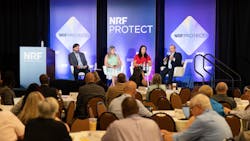This article originally appeared in the July 2023 issue of Security Business magazine. When sharing, don’t forget to mention Security Business magazine on LinkedIn and @SecBusinessMag on Twitter.
I guess it is true what they say – everything is bigger in Texas. Based on my first experience at this year’s NRF Protect in Dallas, I would say there is something to that. Throughout the event, I was able to talk to retail security leaders at all levels of the organization – many of whom shared their challenges, such as increasing threats of violence, the directive to incorporate AI-driven technology into their tech stack, and the need to really look at budgets being directed toward these efforts.
These central themes emerged as more conversations took place, and here were some of my biggest takeaways from NRF Protect, explained:
All about AI
Unsurprisingly, the buzz of the show was all around artificial intelligence (AI). Retail security leaders know they want to use it – and many have budget line items allocated to it – but a large number of them are unsure about where to start. For integrators, education around what is possible (and what is still out of reach) will be necessary as this once almost mythical technology becomes a reality.
Many of the AI conversations centered around the vast amounts of data that is available from software being used across security systems, such as video and access data, occupancy numbers, and more. The goal is to be able to leverage incoming data already being gathered and use it to better analyze and understand buying behavior, as well as predict potential security risks and threats.
Somewhere in between is the need to get rid of burglar alarms and the nuisances, infrastructure, and hefty fines they create for companies and for local law enforcement who have to respond. Leveraging computer vision and AI can help retail security teams achieve these goals.
More Sophisticated and Increasing Levels of Crime
Retailers listened up when Target CEO Brian Cornell recently discussed the rise in violent incidents in the company’s stores; and the numbers support his assessment, with 80% of retailers reporting increased incidents of violence and aggression this past year, in the National Retail Federation’s 2022 Retail Security Survey.
Sobering numbers about the rise in organized retail crime (ORC) were also discussed by Walmart CEO and NRF Board Chairman John Furner during one of the NRF Protect speaking sessions, who said that more collaboration is needed from law enforcement, loss prevention leaders, employees, and retail security leaders to address these issues.
With risks increasing, security leaders in the retail space – as well as their integration partners – play a large role in making decisions that will help mitigate risk and protect employees, customers, and brands from threats.
Doing More with Less
We heard a variation of the following from almost everyone we spoke to: budgets are tightening or staying flat in retail. And the numbers back it up. The recent State of the Industry report from Genetec found that 34% of respondents said their budgets were going to remain flat, while 16% said they were expected to decline. This leaves retail security teams wondering how they can optimize their programs while keeping budget considerations top of mind.
“Doing more with less” becomes a central theme for retail security leaders in this environment, which means having more conversations about ways to use technology investments to solve for other challenges across the business.
Enabling Multiple Departments with Investment
Incoming data from security systems is rich with usable information that can be collected and analyzed – and then actioned – for use across the business. For example, retail locations tend to use a lot of energy for heating and cooling, lighting, and more; in fact, retail buildings in the U.S. spend an average of $1.21 per square foot on electricity, according to National Grid. The ability to integrate incoming occupancy data from video surveillance feeds with HVAC systems to automate heating and cooling can be transformational in cutting costs and energy usage.
The same kind of video data can also be used to better understand in-store foot traffic to be used by merchandising and marketing teams, to count people waiting in line to trigger additional customer service support, or to analyze dwell times to better augment staffing support requirements. Taken together, the usefulness of incoming security data to other departments can mean stronger investment opportunities for physical security teams (aka shared budget) and increased efficiencies across the business.
Increased Consolidation
Retail is a unique vertical market for security leaders, practitioners, and integrators – with each organization handling security, intrusion detection, guarding resources, and loss prevention in different ways. But a commonality we saw was the continued consolidation of multiple local security operations into more regional – and in some cases, national – locations where large-scale oversight is in place. This includes not only retail stores, but also various aspects of the supply chain, such as distribution centers and warehousing.
The benefit to this consolidation is better oversight across the entire supply chain and addressing the challenge that some locations have with outdated IT infrastructure and bandwidth.
For security manufacturers and integrators, all of these takeaways represent a real opportunity to partner together and implement solutions that can better serve retailers and protect employees, customers, and assets from threats – and more importantly, protect these brands.




